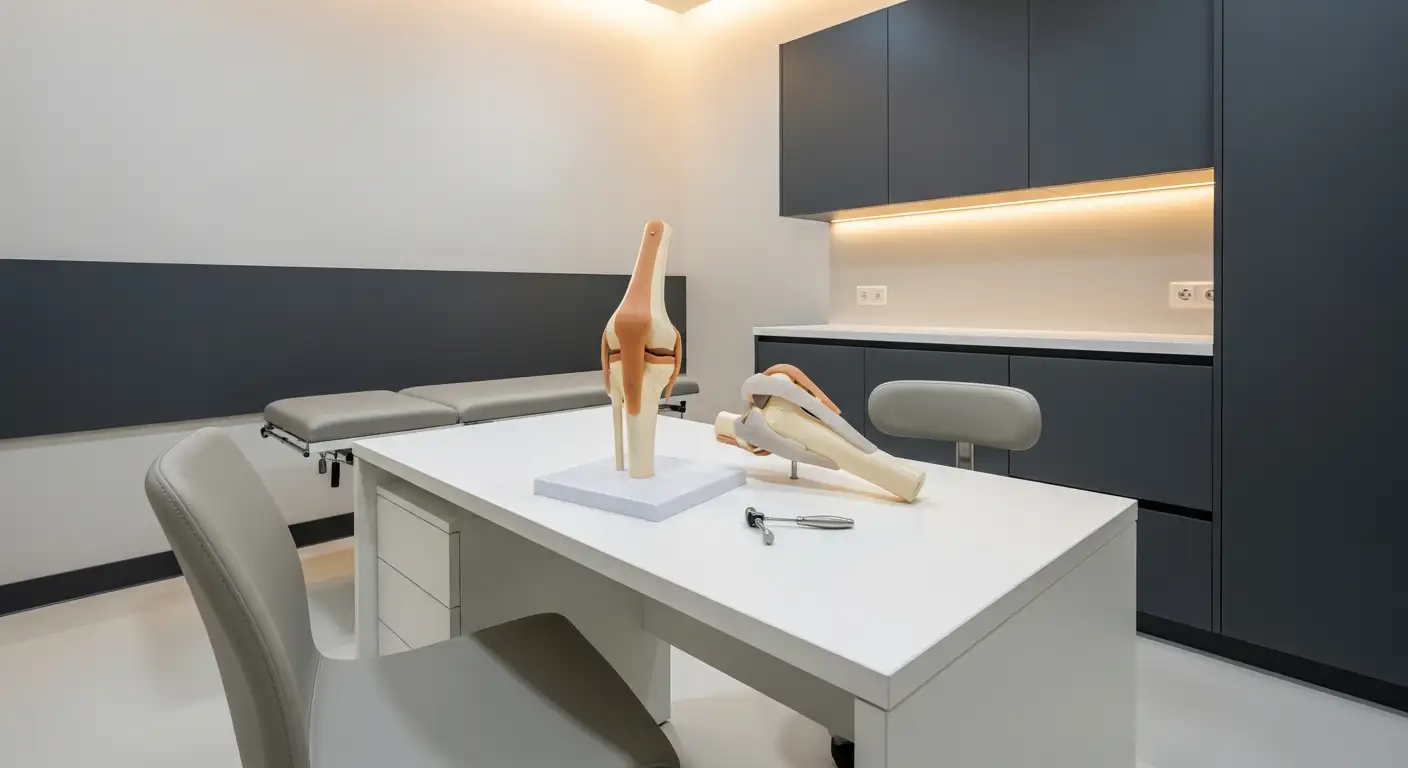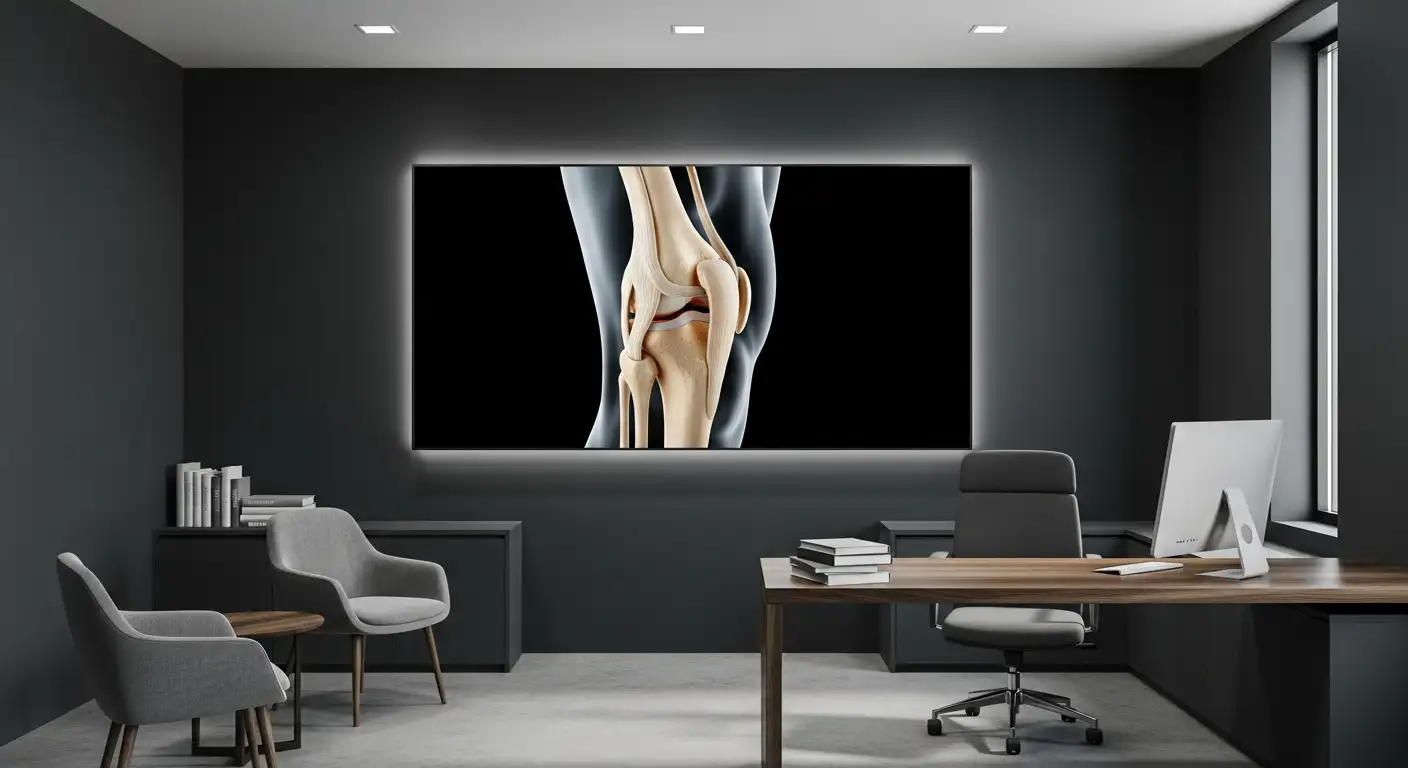Understanding Knee Replacement Surgery
Before delving into the specifics of swelling after knee replacement surgery, it's essential to understand the basics of the procedure itself and what patients can expect post-operation.
Overview of Knee Replacement Procedure
Knee replacement surgery, also known as arthroplasty, is a common procedure that involves replacing a damaged, worn, or diseased knee with an artificial joint. The goal of this surgery is to relieve pain, correct leg deformity, and help the patient resume normal activities.
During the knee replacement procedure, the surgeon removes the damaged portions of the knee joint and replaces them with a prosthesis made of metal and plastic. The prosthesis mimics the function of a normal knee, allowing the patient to move freely again.

Post-Operative Expectations
After the surgery, patients can expect some swelling in the knee and surrounding area. This swelling is a normal part of the body's healing process and usually peaks around the third day post-surgery, then begins to subside over the next few weeks.
The amount of swelling can vary among individuals. Some factors like age, weight, and overall health may influence the extent of swelling post-surgery.
Patients are often encouraged to elevate the leg, especially during the first few days post-surgery, to help reduce swelling. Applying ice and compression to the knee can also aid in reducing swelling after a knee replacement procedure.
It's important to remember that while swelling is a normal part of the recovery process, excessive swelling can lead to increased pain, delayed recovery, prolonged hospital stay, and decreased patient satisfaction. Therefore, efforts should be made to minimize postoperative swelling to improve patient outcomes.
Understanding the knee replacement procedure and knowing what to expect post-surgery can help patients better manage their recovery. In the next sections, we'll explore more about the causes of post-operative swelling, techniques to reduce swelling, and how to recognize potential complications.
Managing Swelling Post-Surgery
One of the most common experiences patients face after knee replacement surgery is swelling. Understanding its causes and effective ways to manage it can significantly improve the overall recovery process.
Causes of Post-Operative Swelling
Swelling after knee replacement surgery is a normal part of the body's response to the surgical procedure. It typically peaks around the third day post-surgery and then begins to gradually subside over the next few weeks [1].
The extent of the swelling can vary among individuals. Factors such as age, weight, and overall health may influence the degree of swelling experienced post-surgery.
Excessive swelling post-surgery can lead to increased pain, delayed recovery, prolonged hospital stay, and decreased patient satisfaction. Therefore, it's crucial to take measures to manage and reduce swelling effectively.
Techniques to Reduce Swelling
There are several strategies to manage and reduce swelling after knee replacement surgery:
- Elevation: Keeping the leg elevated, especially during the first few days post-surgery, can help reduce swelling. This aids in draining the fluid away from the knee area and back towards the heart.
- Ice and Compression: Applying ice and using compression wraps can also aid in reducing swelling. The cold temperature from the ice helps contract the blood vessels, reducing the flow of blood and other fluids to the knee area. Compression wraps provide gentle pressure that can prevent fluid buildup in the knee area.
- Movement and Physical Therapy: Gentle movements and physical therapy can also help reduce swelling. Although it might be uncomfortable, moving the knee joint helps pump the excess fluid away from the knee area. Physical therapy exercises can be performed under the guidance of a qualified physical therapist.
- Medication: In some cases, doctors may prescribe medications to help manage the swelling. Always take these medications as directed by your healthcare provider.
Efforts should be made to minimize postoperative swelling to improve patient outcomes. Always consult with your healthcare provider or physical therapist for guidance on the best methods to reduce swelling after your knee replacement surgery.
Recognizing Potential Complications
While swelling after knee replacement surgery is a normal part of the healing process, it's important to recognize potential complications that could arise. These can include signs of infection and risks associated with excessive swelling.
Signs of Infection
Infection is a serious complication that needs immediate attention. While it is not common, it's crucial to be aware of the signs and seek medical assistance if they manifest. These signs could include:
- Increased pain around the surgical area
- Redness and heat around the surgical site
- Drainage from the wound
- Fever or chills
In addition to these, swelling after knee replacement surgery can be a sign of complications such as a blood clot, which has the potential to cause pain and swelling. In such cases, doctors may prescribe anticoagulant medicines to assist in the treatment [3].
Risks of Excessive Swelling
Excessive swelling after knee replacement surgery can lead to increased pain, delayed recovery, prolonged hospital stay, and decreased patient satisfaction. Patients who experience excessive swelling may also suffer from stiffness, prolonged wound drainage, and limited range of motion, increasing their overall risk of morbidity [2].
In addition to these complications, postoperative swelling can lead to functional impairment, affecting the patient's ability to achieve optimal functional recovery and range of motion. Therefore, management strategies to reduce swelling are crucial for enhancing patient rehabilitation [2].
Effective management of postoperative swelling after knee replacement surgery is integral to preventing complications and supporting better patient satisfaction, functional outcomes, and overall success of the surgical intervention [2].
In conclusion, it's crucial to monitor the swelling after knee replacement surgery closely. Any signs of infection or excessive swelling should be promptly reported to the healthcare provider to prevent potential complications. It's also essential to follow the prescribed postoperative care plan to support optimal recovery and successful surgical outcomes.
The Role of Physical Therapy
Physical therapy plays a significant role in post-operative care, particularly in managing swelling after knee replacement surgery. It serves multiple purposes, from reducing swelling to increasing range of motion and overall mobility.
Benefits of Post-Surgery Exercise
Physical activity is often recommended post-surgery to help reduce swelling and improve function after knee replacement surgery [4]. More active patients tend to have less swelling and bruising following the procedure due to improved muscle function.
Regular gentle exercise, including walking, can also help stimulate blood flow and reduce the risk of blood clots. It's important to note that the intensity and duration of exercise should be gradually increased under the guidance of a physical therapist to avoid overexertion.
Physical Therapy Techniques
A variety of techniques are employed in physical therapy to manage swelling and improve patient recovery outcomes post-knee replacement surgery. Multimodal approaches, such as cryotherapy (use of cold therapy), compression, and early mobilization, can potentially reduce swelling and improve recovery outcomes [2].
Aside from these, physical therapists may also recommend specific exercises tailored to the patient's condition and recovery progress. These exercises aim to increase the strength and flexibility of the knee joint, thereby facilitating mobility and reducing the risk of further complications.
In addition to exercise and movement, other strategies such as elevation of the leg and the application of ice packs to the surgical site can also be beneficial. These techniques, often used in conjunction with compression garments, can help reduce swelling and pain.
Physical therapy is an integral component of post-operative care, and its role in managing swelling and improving function after knee replacement surgery cannot be overstated. By working with a qualified physical therapist, patients can better navigate the recovery process and maximize their post-operative outcomes.
Long-Term Outcomes of Knee Replacement
Understanding the long-term outcomes after knee replacement surgery is essential for setting realistic expectations and planning post-operative care. This section discusses the effects on mobility and pain and the lifespan of a knee replacement.
Effect on Mobility and Pain
Knee replacement surgery, also known as total knee arthroplasty (TKA), aims to improve mobility and alleviate pain in individuals suffering from severe knee joint damage. It has a high success rate, with 95% of patients experiencing good to excellent results within 5-10 years post-operation. However, chronic pain and restricted knee motion can be a significant issue for some patients, particularly for those undergoing revision surgery.
A 2019 study in the United Kingdom, which included 29 primary TKA patients and 32 revision TKA patients, found higher pain levels in revision patients compared to primary patients. The study assessed pain levels using the Western Ontario and McMaster Universities Osteoarthritis Index (WOMAC) scores. The time from primary to revision surgery ranged from 8 months to 30 years. Interestingly, there was no decreasing trend in inflammatory marker levels with increased time from primary surgery observed in synovial fluid [6].
Lifespan of a Knee Replacement
The lifespan of a knee replacement can vary based on several factors, including the patient's age, weight, activity level, and the type and quality of the prosthesis used. On average, a knee replacement can last for 15-20 years. However, some components of the replacement may wear out or loosen over time, requiring a revision surgery.
Research has shown that elevated levels of pro-inflammatory mediators are observed in revision total knee replacement (TKR) patients compared to primary TKR patients. This indicates an active and ongoing chronic inflammatory process, even years after the initial surgery. The findings suggest the presence of chronic inflammation even years after the initial knee surgery, highlighting a potential target for biological therapy in knee pain and stiffness post-TKR.
This persistent inflammation, as indicated by elevated expression of several inflammatory markers in synovial fluid (SF), fat pad (FP), and synovial membrane (SM) in revision knees compared to primary knees, could potentially influence the lifespan of a knee replacement [6].
While knee replacement surgery can significantly improve quality of life for many patients, it's important to have realistic expectations about the recovery process and long-term outcomes. Regular follow-ups with the orthopedic surgeon and a comprehensive post-operative care plan can help manage any potential complications and ensure the best possible results.
Personalizing Post-Operative Care
Understanding the unique aspects of an individual's knee surgery and post-operative process is crucial for a successful recovery. Post-surgery care is not a one-size-fits-all approach and should be tailored to each patient's individual needs and circumstances.
Individual Factors Influencing Recovery
Post-operative recovery varies from person to person, and several factors can influence the healing process. It is important to recognize that every surgery and individual is unique in their recovery process. Factors such as the surgical technique used, the individual's overall health, the presence of underlying conditions, and the patient's commitment to following post-operative care instructions can all impact recovery.
Research has shown that chronic inflammation can persist even years after the initial knee surgery. This inflammation can contribute to chronic pain and restricted knee motion after total knee arthroplasty (TKA), with pain levels found to be higher in revision patients compared to primary patients. This further underscores the importance of personalized care to manage these potential complications effectively.
Tailoring Care to Personal Needs
To ensure proper recovery, it is recommended to have a conversation with the surgeon and care team post-surgery. This allows the patient to receive personalized advice on how to manage pain and swelling effectively. Overreliance on pain medications or skipping physical therapy sessions due to discomfort can lead to problems during recovery.
In some cases, the use of minimally invasive techniques during knee replacement surgery can help limit damage to the knee and surrounding components, leading to better symptom control and a faster recovery process.
Chronic inflammation, as seen in revision cases, is an ongoing issue and requires targeted and personalized care. Pro-inflammatory and matrix deposition markers are heightened in these patients, suggesting the potential for targeted biological therapy.
By understanding these individual factors and tailoring post-operative care to personal needs, patients can better manage swelling and other symptoms after knee replacement surgery. This personalized approach can help promote a successful recovery and enhance long-term outcomes.
References
[1]: https://www.cortho.org/knee/swelling-after-knee-replacement/
[2]: https://pubmed.ncbi.nlm.nih.gov/22340316/
[3]: https://www.nhs.uk/conditions/knee-replacement/complications/
[4]: https://www.healthline.com/health/total-knee-replacement-surgery/managing-postoperative-pain
[5]: https://www.ozorthopaedics.com.au/faqs-after-knee-replacement-surgery.html
[6]: https://www.ncbi.nlm.nih.gov/pmc/articles/PMC6851711/
[7]: https://drhermanbotero.com/5-tips-for-managing-pain-bruising-and-swelling-after-knee-replacement-surgery/





